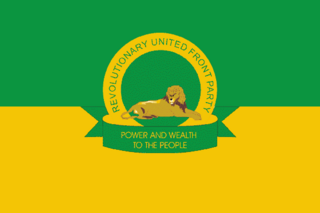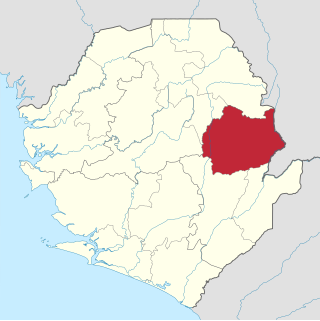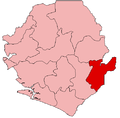
Sierra Leone, officially the Republic of Sierra Leone, is a country on the southwest coast of West Africa. It shares its southeastern border with Liberia, and the northern half of the nation is surrounded by Guinea. Covering a total area of 71,740 km2 (27,699 sq mi), Sierra Leone has a tropical climate, with diverse environments ranging from savanna to rainforests. The country has a population of 7,092,113 as of the 2015 census. Freetown is the capital and largest city. The country is divided into five administrative regions, which are subdivided into 16 districts.
Sierra Leone first became inhabited by indigenous African peoples at least 2,500 years ago. The Limba were the first tribe known to inhabit Sierra Leone. The dense tropical rainforest partially isolated the region from other West African cultures, and it became a refuge for peoples escaping violence and jihads. Sierra Leone was named by Portuguese explorer Pedro de Sintra, who mapped the region in 1462. The Freetown estuary provided a good natural harbour for ships to shelter and replenish drinking water, and gained more international attention as coastal and trans-Atlantic trade supplanted trans-Saharan trade.

The Revolutionary United Front (RUF) was a rebel group that fought a failed eleven-year war in Sierra Leone, beginning in 1991 and ending in 2002. It later transformed into a political party, which still exists today. The three most senior surviving leaders, Issa Sesay, Morris Kallon and Augustine Gbao, were convicted in February 2009 of war crimes and crimes against humanity.

Alhaji Ahmad Tejan Kabbah was a Sierra Leonean politician who served twice as the 3rd President of Sierra Leone, from 1996 to 1997 and again from 1998 to 2007. An economist and attorney by profession, Kabbah spent many years working for the United Nations Development Programme. He retired from the United Nations and returned to Sierra Leone in 1992.

Kissidougou is a city in southern Guinea. It is the capital of in the Kissidougou Prefecture. Following intensified conflicts in Sierra Leone and Liberia during the fall and winter of 2000, many people from the city of Guéckédou fled to Kissidougou and stayed. As of 2014 it had a population of 102,675 people.
The Sierra Leone Civil War (1991–2002), or the Sierra Leonean Civil War, was a civil war in Sierra Leone that began on 23 March 1991 when the Revolutionary United Front (RUF), with support from the special forces of Liberian dictator Charles Taylor's National Patriotic Front of Liberia (NPFL), intervened in Sierra Leone in an attempt to overthrow the Joseph Momoh government. The resulting civil war lasted 11 years, enveloping the country. It left over 50,000 dead.
Kangama is a town in Kailahun District in the Eastern Province of Sierra Leone, near the border of Liberia. It is the headquarters of the Kissi Teng Chiefdom.

Bonthe District is a district that comprises several islands and mainland of the Atlantic Ocean in the Southern Province of Sierra Leone. Bonthe is one of the sixteen districts of Sierra Leone. Its capital is the town of Bonthe Island and its largest city is Bonthe, on Sherbro Island. As of the 2015 census, the district had a population of 200,730. Bonthe District is one of the sixteen districts of Sierra Leone. Bonthe District is subdivided into eleven chiefdoms.

Kono District is a district in the Eastern Province of Sierra Leone. Its capital and largest city is Koidu Town. Motema is the second most populous city in the district. The other major towns in the district include Yengema, Tombodu, Jaiama Nimikor and Sewafe. The district is the largest diamond producer in Sierra Leone. The population of Kono District is 505,767. Kono District borders Kenema District to the southwest, The Republic of Guinea to the east, Koinadugu District to the northeast and Kailahun District to the southeast. Kono District is divided into fourteen chiefdoms.

Kambia District is a district in the North West Province of Sierra Leone. Its capital and largest city is the town of Kambia. As of the 2015 census, The District had a population of 343,686. Kambia District borders the Republic of Guinea to the north, Port Loko District to the south and Karene District to the east. The district provides an important Trade route to or from the Sierra Leonean capital Freetown to the Guinean capital Conakry.

The Kissi people are a West African ethnolinguistic group. They are the fourth largest ethnic group in Guinea, making up 6.2% of the population. Kissi people are also found in Liberia and Sierra Leone. They speak the Kissi language, which belongs to the Mel branch of the Niger–Congo language family. The Kissi are well known for making baskets and weaving on vertical looms. In past times they were also famous for their ironworking skills, as the country and its neighbors possess rich deposits of iron. Kissi smiths produced the famous "Kissi penny,"
Koindu is a town in Kailahun District in the Eastern Province of Sierra Leone. Koindu should not be confused with Koidu, which is a major diamond mining town in Kono District and market center. The population of Koindu is estimated at 16,751. Koindu lies approximately 63 miles from Kenema and about 230 miles east of Freetown.
Mattru Jong commonly known as Mattru is the capital of Bonthe District in the Southern Province of Sierra Leone. Mattru Jung is located on the mainland of Bonthe District, along the Jong River, 52 miles southwest of Bo. The town is the seat of Mongerewa Jong Chiefdom, and is the home of Mongerewa Jong Paramount Chief Alie Badara Sheriff III. The town's current estimated population is about 20,000 people. In 2010 it was 8,199, and in the 2004 census the town had a population of 7,647.

United Nations Security Council resolution 1346, adopted unanimously on 30 March 2001, after recalling previous resolutions on the situation in Sierra Leone, the Council extended the mandate of the United Nations Mission in Sierra Leone (UNAMSIL) for a further six months and increased the size of its military component.

Liberia – Sierra Leone relations refers to the historical and current relationship between Liberia and Sierra Leone. The two countries signed a non-aggression pact in 2007 when Sierra Leonean President Ernest Bai Koroma took office. In January 2011, an African diplomat described relations as "cordial".
Yenga is a village in Kissi Teng Chiefdom, Kailahun District in the Eastern province of Sierra Leone. The village is at the international border between Sierra Leone and Guinea.
Kissi Tongi Chiefdom is a chiefdom in Kailahun District of Sierra Leone with a population of 33,457. Its principal town is Buedu. During the Sierra Leone Civil War the Kissi Tongi Chiefdom was one of the major strongholds of the Revolutionary United Front (RUF). The War Office of the RUF was opened in Buedu in February 1998, and Kissi Tongi was one of the last chiefdoms to be disarmed in January 2002.
Jawei Chiefdom is a chiefdom in Kailahun District of Sierra Leone with a population of 42,635. Its largest town and headquarters is Daru.
The RFDG Insurgency was an insurgency in Guinea by the RFDG, a rebel group supported by Liberia and the Sierra Leonean rebel group RUF. The fighting was closely connected to the Second Liberian Civil War and the Sierra Leone Civil War and primarily occurred on Guinea's borders with Liberia and Sierra Leone. Beginning in September 2000, some of the most intense fighting took place around the city of Guéckédou in December, before the level of violence decreased in 2001.

The Guinea–Sierra Leone relations are foreign relations between two neighbouring West African nations. After gaining independence initial relations between the two countries in the Cold War context turned to be tense due to conservative strategy of Sierra Leone and much more Pan-African and pro-socialist leanings of Guinea.











